[one_half padding=”0 0 0 0px”]
CMMG Mk4 300 Blackout
[/one_half]
[one_half_last padding=”0 0 0 0px”]
[/one_half_last]
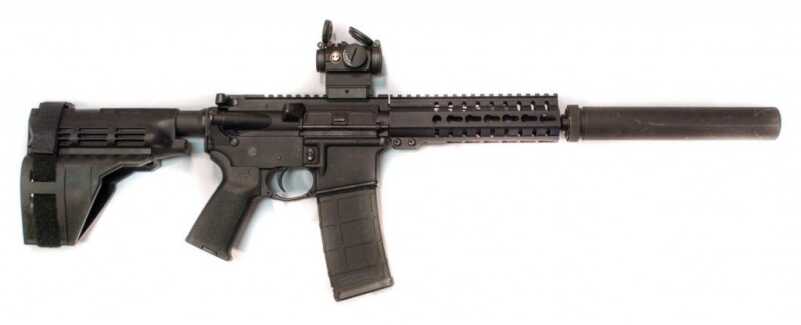
OK, so this one was temporarily souped up. No worries, there’s a factory configuration photo here too.
I think the 300 AAC Blackout caliber was really made for short barrels. Don’t get me wrong, I have a 300 Blackout AR-type rifle with a 16-inch barrel and love it. I just think the flexibility of the caliber really shines in short and compact configurations.
When shooting subsonic, velocity loss resulting from a shorter barrel is a non-issue, and perhaps even a good thing. I assume, of course, that you’re shooting with a suppressor in subsonic configuration. Staying comfortably below that moving target known as the sound barrier is a benefit when using a silencer as there is no supersonic “crack” from the bullet.
When shooting supersonic, I don’t think there’s a drawback to short barrel configurations either. In my opinion, 300 Blackout was never designed as a long range cartridge anyway. There are certainly better options to reach out there, like 6.5 Grendel or 6.8 SPC to name just a couple. Part of the design impetus was to increase terminal performance over that of 5.56 rounds. 300 Blackout shoots a heavier .308 bullet, which many believe is a better fight stopper than a lighter .224 diameter projectile. Whatever side of that argument you take, the point is that a couple hundred feet per second velocity loss from a shorter barrel really isn’t significant.
A Tour of the CMMG Mk4 300 Blackout Pistol
With all that said, I jumped at the opportunity to put a CMMG Mk4 300 Blackout pistol through it’s paces. I’d shot AR pistols before but had never really spent quality time getting to know them. What better way to get acclimated than one chambered in one of my favorite calibers?
The CMMG Mk4 looks like any other AR pistol at first glance, but when you examine it more closely, you’ll see some important upgrades. First, the grip is a Magpul MOE pistol grip. You’ll also notice that the Mk4 comes with a Magpul PMAG rather than some no-name, lowest bidder 30-round magazine. You also might notice the (very) nice KeyMod forend. That’s the CMMG RKM7 hand guard. It’s got Picatinny rail along the entire top and KeyMod attachment points at the 3, 6, and 9 o’clock positions. Each of the three KeyMod rails has six KeyMod holes for direct attachment of KeyMod compatible accessories or rail segments. My sample gun came with a two-inch rail segment that occupies three KeyMod holes.
You’ll also see two quick attach / detach holes towards the back of the hand guard – one on either side. Speaking of sling attachment points, you’ll find two sling attachment points between the buffer tube and receiver. These are small details, but indicative of attention to important doing it right. When people start talking about being able to “get X, Y, or Z gun for less money”, I always look for little details like these that separate one gun from another.
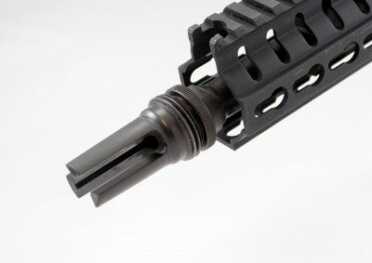
From the factory, the Mk4 comes with an A2 flash hider. I added this SilencerCo Trifecta flash hider and suppressor mount to make it easier to test with and without the silencer.
The trigger on the CMMG Mk4 is a standard single stage, but it feels a heck of a lot better than most factory AR triggers I’ve ever tried. It’s got the slightest bit of zero-resistance take up, followed by the slightest of bumps then a near immediate, and very crisp break. I repeatedly measured the pull weight at 4.25 pounds with my Timney Triggers gauge. I’ve gotten spoiled by aftermarket triggers and would always upgrade at some point, but this one is one of the best “stock” AR triggers I’ve run across in quite a while. There’s none of the typical grit that feels like dragging a brick across your teeth. Wow, that hurts just writing it.
The barrel is eight inches in length and includes an A2-style flash hider. The twist rate is 1:7, presumably to help stabilize those 220 grain subsonic bricks that you’ll want to shoot from this gun. It’s made from 4140 CrMo steel with a Nitride finish. Underneath the stock flash hider, threads are ⅝”-24 and compatible with most any .308 suppressor. While we’re talking about the barrel, I should note that the Mk4 uses a pistol-length gas system. We’ll talk more about that later.
Moving backward along the gun, you’ll find the standard stuff: forward assist, standard safety lever, and charging handle. The upper receiver is forged aluminum M4-type and the lower is standard AR-15. One thing I did notice is that the rear half of the buffer tube is textured. I didn’t have the chance to ask the CMMG folks about this, but I would assume it provides a little extra grip in the event you want to mount an arm brace or similar device to the tube. Those generally just slip on, so the texture helps keep things in place.
I might suggest doing something to the gun to scream “this is chambered in 300 AAC Blackout!” With the short barrel entirely covered by the KeyMod rail, there’s no simple way to identify the chambering other than looking in the bore. If it’s your gun, for your use, it’s not really an issue – just be careful taking it to the range and letting others shoot without careful oversight. Not too long ago, I saw someone blow up a 5.56mm AR by stuffing a magazine of 300 Blackout into it while the owner was otherwise occupied. Clearly, inadvertently putting a .223 / 5.56mm cartridge in a Blackout rifle won’t have the same result. I suppose I just like clear markings of chamber type. Just to be clear, the barrel is stamped with “CMMG 300 BLK” it’s just under the handguard and hard to see, especially if you have accessories on the gun.
Shooting a Pistol-Rifle-Pistol
While you can shoot this pistol, or any other AR pistol, as-is out of the box, it’s a new experience in ergonomics. This is mainly due to the exposed buffer tube extending behind the pistol body. I did some shooting with no accessories, sling or brace, just to get a feel for handling the pistol. My natural tendency, and the wrong thing to do with this type of gun was to hold it too close to my face. The buffer tube tends to get in the way and as the gun moves under recoil, it might just ding your mouth. Even still, holding it two-handed, with no other support, I could shoot close range targets effectively, say, inside of 50 yards. What really makes an AR pistol shine is using alternative support. I tried a couple of different methods.
First I added a single point sling, attaching it to one of the rings between the buffer tube and receiver. The idea of this method is to push the gun forward against the tension of the sling. This accomplishes two things. You get stability from the tension and, more importantly, you don’t have to worry about your teeth getting cracked by the buffer tube. I shot like this at some hundred yard targets, and while it’s feasible to hit man sized targets without too much trouble, it’s not really precise at that range. I think the sling method might be good for bodyguards, security teams and other short-range scenarios where extreme precision at range is not really a factor. You can also use a two-point sling in a similar fashion; you just won’t get the same level of benefit as using a two-point sling with a rifle also anchored to your shoulder.
What I really liked, was putting something on the buffer tube to provide a cheek weld point. Not that you need to hold it against your cheek to shoot, it just felt more natural to me and provided a better sight picture with the gun in a bit closer to my body. This led me to…
Shooting with the Sig Sauer SB-15 Forearm Brace
The Sig SB-15 Forearm Brace just slides onto the buffer tube. There are no permanent or semi-permanent attachments, probably by design. Between the textured buffer tube surface and a small nub on the brace that tucks into the receiver, I found that the brace firmly mounted on the gun. It wasn’t wanting to move around with moderate use. If you really want to make sure it won’t move, perhaps the classic golf club tape method would lock things in place. Adding some additional friction might also allow you to position the brace at the exact position you want instead of jammed all the way up against the receiver.
As I wanted to understand the original intent of the Sig brace, I first used it strapped to my forearm. Soft rubber flaps wrap around your forearm from the top. Once in place, you cinch up a velcro strap to hold it firmly in place. This was surprisingly stable! My arm handled the weight of the gun and if I wanted, I could release pressure from the pistol grip almost entirely. My firing hand was not required to support the gun at all – I could focus on aim and trigger control. While I felt a bit like a Transformer and yes, that was kind of fun, it was a very effective solution. The only drawback was sight alignment. With the pistol strapped on to my forearm, the longitudinal sight plane started farther out to my side, then angled towards the center. Basically, the geometry of my arm created the angle, so I had to lean my head to the right (my strong side) to get a proper sight picture. It wasn’t that big of a deal though.
Once the brace was mounted on the CMMG, I found that even holding the gun with my cheek on the rubber brace surface made a world of difference. While any type of cover on the buffer tube, even foam rubber, would be a big plus, the Sig brace did an admirable job of cheek and face protection no matter how you hold the Mk4 pistol.
If you plan on using the Sig brace in any other fashion than it’s original intent as a forearm support, be very, very careful about checking the latest ATF rulings. Originally, the ATF deemed that how one chose to use the brace was irrelevant provided its design intent was to support one-handed shooting. Recently, however, the ATF has issued an open letter that appears to reverse their initial stance on the issue. Sig Sauer and other companies are contesting the ruling, so the final outcome remains to be seen. Before using this brace in creative ways, be sure to check on the latest word from the ATF. Don’t rely on this article or any other for legal advice, be sure to obey all local and federal laws when you put together your AR pistol with this or any similar configuration.
Accuracy
I wanted to put this on a rest and test for accuracy just for the heck of it. I didn’t get ridiculously scientific because this is a pistol designed for shorter range applications. I brought some Blackhawk! Sportster Titan rests to the range to do some very quick and dirty supported shooting. The first thing I found was that getting a solid support wasn’t all that easy. When testing a rifle, you can rest the front and back fairly easily. When testing a pistol, the whole gun can be fairly well supported on sandbags. The AR pistol is somewhere in between and while I could support the hand guard on a rest, getting solid support further back was a bit challenging. Much of the problem was that the Sig brace is made of soft rubber, so putting on a rest didn’t accomplish much – it wanted to wobble around. I persevered and tried both subsonic and supersonic loads anyway. Oh, even at risk of looking somewhat ridiculous, I mounted a full-size rifle scope, a Nikon P-300 Blackout model, to get some precision at a 50-yard distance. Yes, it looked a bit silly on the pistol, but I did get a decent sight picture.
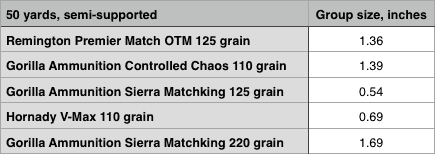
Don’t take these results as any indication of the pistol’s mechanical accuracy. If anything, the numbers may imply ease of shooting with accuracy. I was just curious, nothing more, nothing less. I’m confident that had I bolted this gun to a table, the groups would have been much smaller.
[one_half]
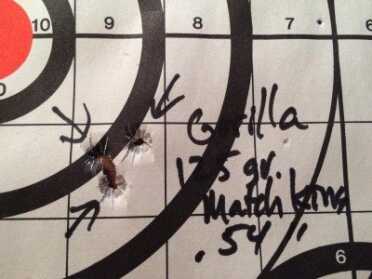
It’s hard not to get good accuracy with Sierra Matchking bullets. Even with an unstable rest, this Gorilla 125 grain Matchking did pretty darn good.
[/one_half]
[one_half_last]
[/one_half_last]
So the Nikon optic, while great for a rifle, was not the ideal solution for this pistol. What turned out to be an ideal sighting solution was the Aimpoint Micro T-2. I had it on the high AR-style quick-detach mount, and with either sling or Sig brace configuration it was right where I wanted it. This optic was easy and fast to acquire on the CMMG. For really close range, the Aimpoint Micro’s tube is small enough to use as a crude aiming method even without the red dot turned on. When I actually used the red dot sight, I had no trouble engaging targets within 100 yards.
Just for fun, I also tried the Trijicon ACOG for 300 Blackout. This one features a dual reticle for supersonic and subsonic ammunition. The crosshairs indicate hold points for supersonic loads while two large dots indicate 50 and 100 yard hold points for subsonic ammo. Like the Aimpoint, it’s on a higher mount and fell right in line with my sight plane. Both solutions are ideal for “two eyes open” shooting with a gun like this.
Function

One thing I noticed – with the pistol-length gas system, this gun ejected brass with authority. Check out the “brass stain.”
300 Blackout guns can be finicky. When designing the gas / spring balance, four sometimes opposing configurations need to be considered and all need to work. First, there are two extremes of ammunition and corresponding pressure: supersonic and subsonic. It’s easy to make a gun work with one or the other. What’s hard is making the subsonic range function without beating the gun to death when shooting supersonic with significantly higher gas pressure. Then you have to account for suppressor use, which changes the whole dynamic. With a silencer, you have four possible shooting configurations.
Most 300 Blackout rifle / pistol manufacturers are gravitating towards pistol-length gas systems and the CMMG Mk4 is no exception.
I did most of my function testing with the CMMG using one of two different suppressors. Using a suppressor will definitely help reliable function with the subsonic round, but I felt that was a fair test of this particular gun. It’s hard to imagine getting a gun like this without planning on adding a suppressor. On the other hand, I get it. They’re expensive, and you have to pay the tax, then you have to wait. If there was ever a gun designed to be used suppressed, this is it.
For subsonic shooting, I tried both a SilencerCo / SWR Octane 45 and a SilencerCo / SWR Specwar 762. The Octane is a pistol suppressor and only suitable for 300 Blackout subsonic rounds. It’s not made for the higher pressure of supersonic loads. The Specwar 762 can handle anything .308, so I used that for all types of 300 Blackout ammunition.
Function was perfect with name-brand 300 Blackout rounds. Only one ammo type would not function reliably and that was the Cooper Cartridge 245 grain subsonic cinder blocks I had on hand. Well, technically they’re not really made of cement, they’re lead and have flat points. Then again, I’ve not gotten these cartridges to cycle in any semi-automatic gun to date. I suppose they’re intended for bolt actions. Taking the suppressor off, I was able to encourage a few failures to cycle with a PNW 200 grain subsonic load. The mainstream ammo worked fine.
On the supersonic side, the function question was irrelevant. Everything ran like a champ, suppressor or no suppressor.
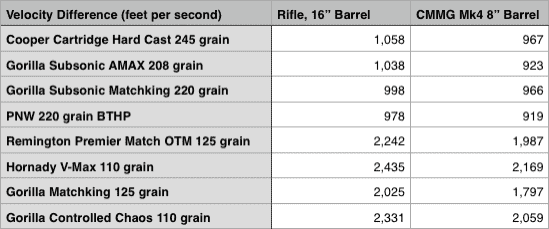
The Bottom Line
This pistol-rifle-pistol was a lot more fun to shoot than I expected. Without a suppressor mounted, it’s super compact with its 8-inch barrel. The flash hider barely extends past the hand guard. Even with a suppressor mounted, it’s still amazingly compact. At just 5.3 pounds unloaded, it’s incredibly portable too. It would make a great bug out or car gun as it would easily fit into transport cases like Blackhawk! Diversion bags. If I were able to keep this one, the Sig brace would stay and I’d permanently replace the flash hider with a suppressor mount version. Other than that, it’s good to go.
MSRP of the CMMG Mk4 300 Blackout Pistol is $1,049.95. CMMG also makes Mk4 pistols in 9mm and .22LR.
[one_half]
[/one_half]
[one_half_last]
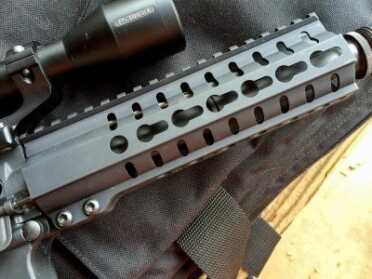
KeyMod attachment points are at the 3, 6, and 9 o’clock positions. The Picatinny rail covers the receiver and hand guard.
[/one_half_last]

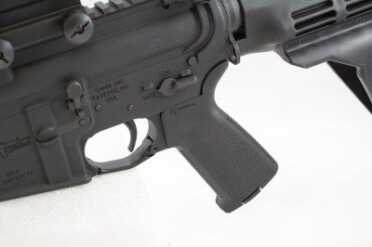
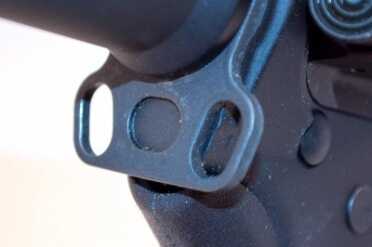
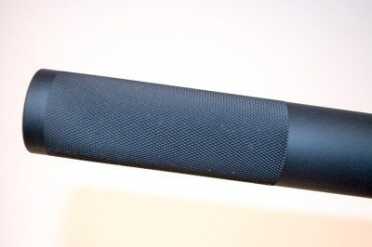
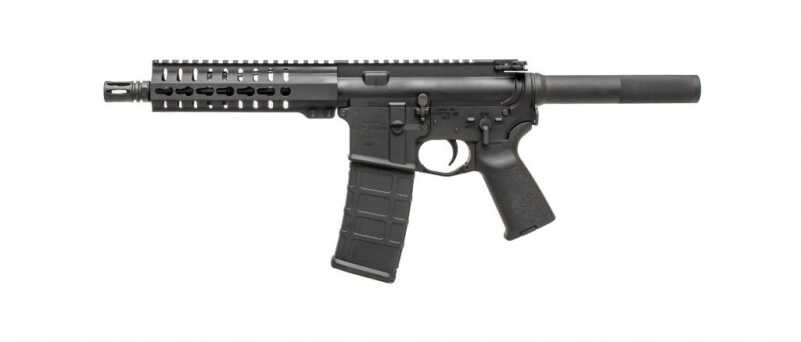
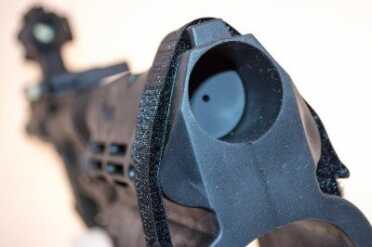
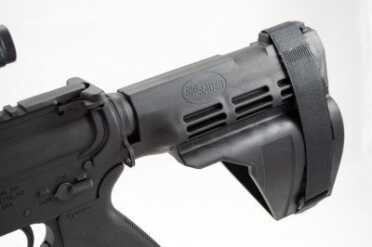
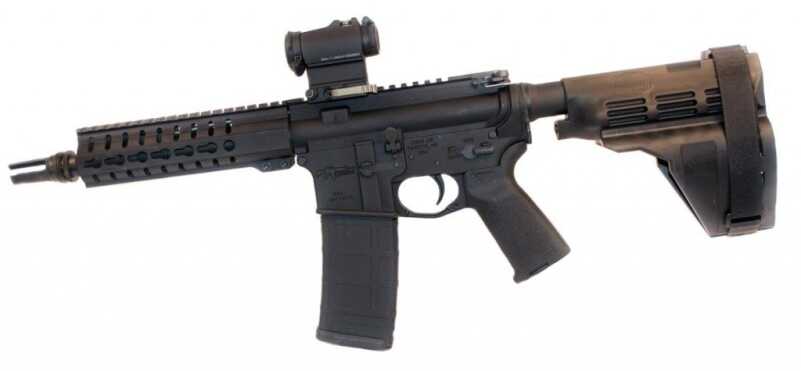
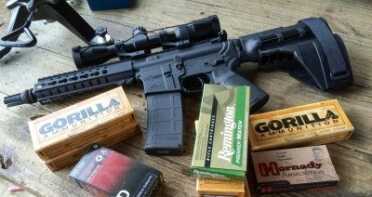
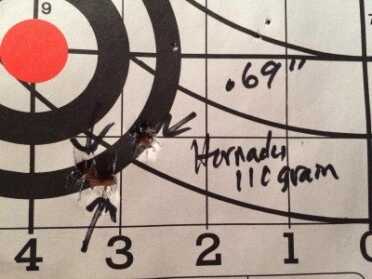
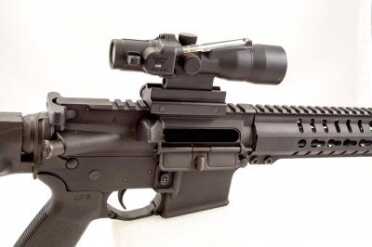
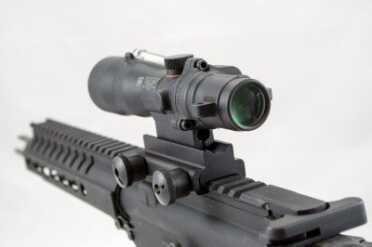
Is or will the U.S Military adopt the 300 Blackout?
Have they considered it at all?
Can anyone tell me the part number fire the magpul sling attachment that fits over the arm brace?
Interesting concept gun with a growing following, although when compared against the 762-39 I don’t quite get the positive verses negative argument other than supersonic / subsonic accuracy verses stopping power.
Any way I just put my order in for a .308 lower assembly so I don’t have a dog in this fight.
I think that the main benefit of the 300 over the 762×39 is that it feeds reliably through your typical AR mags and AR15 platforms. Although, the original reason it was invented (300 whisper ring any bells?) was to fire through single shot (a la Thompson Center) pistols as a low recoil hunting round. In the late, great Paul Harvey’s words, “Now you know…the rest of the story.”
Joe –
The ballistics on the 300 and 39 are very similar. The biggest advantage the 300 has over the 39 and most other calibers is short barrel performance. Velocity drop with an 8″ and shorter barrel is less. The other issue with the 39 is it tends to not work as well in an AR platform. There have been more options released over the last year or so and more to come, so this may become less of an issue.
Robert
Thanks, Tom for pointing out the faster burn for the subsonic ammo. I was thinking about ( won’t name names) about a pistol that shoots .308 with a huge velocity loss due to a 8.5 Barrel due to some unturned powder, clog up suppressor too?
Restricted to only.308. (7.62 x 51 mm). No other calibers, no protruding buffer tube, just an end cap. I know velocity is very critical,, ability to shoot without Brace too, no buffer tube, wouldn’t ( personal choices) for CLOSE QUARTERS.
Anybody comment on this, in terms of stopping power.
I would live to know because.300 Blackout seems to be better, I was ready to buy the.308 recently but now, I am mixed, should not really complain that there is a choice.
Thank you for the review. The velocity for the two 220gr. Load’s is very interesting. Sort of vindicate’s the 7.5 ” barrel. S. Davis
My theory is that those subsonic rounds behave more like pistols cartridges, meaning a fast pressure curve so a longer barrel isn’t required to contain pressure until the burn is done.